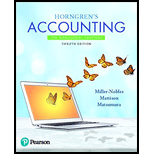
Decision Case 23-1
Suppose you manage the local Scoopy’s ice cream parlor. In addition to selling ice cream cones, you make large batches of a few flavors of milk shakes to sell throughout the day. Your parlor is chosen to test the company's 'Made-for-You' system. This new system enables patrons to customize their milk shakes by choosing different flavors.
Customers like the new system and your staff appears to be adapting, but you wonder whether this new made-to-order system is as efficient as the old system in which you just made a few large batches. Efficiency is a special concern because your performance is evaluated in part on the restaurants efficient use of materials and labor. Your superiors consider efficiency variances greater than 5% to be unacceptable.
You decide to look at your sales for a typical day. You find that the parlor used 390 pounds of ice cream and 72 hours of direct labor to produce and sell 2,000 shakes. The standard quantity allowed for a shake is 0.2 pound of ice cream and 0.03 hour of direct labor. The
Requirements
1. Compute the efficiency variances for direct labor and direct materials.
2. Provide likely explanations for the variances. Do you have reason to be concerned about your performance evaluation? Explain.
3. Write a memo to Snoopy’s national office explaining your concern and suggesting a remedy.
Want to see the full answer?
Check out a sample textbook solution
Chapter 23 Solutions
Horngren's Accounting (12th Edition)
 Cornerstones of Cost Management (Cornerstones Ser...AccountingISBN:9781305970663Author:Don R. Hansen, Maryanne M. MowenPublisher:Cengage Learning
Cornerstones of Cost Management (Cornerstones Ser...AccountingISBN:9781305970663Author:Don R. Hansen, Maryanne M. MowenPublisher:Cengage Learning Managerial AccountingAccountingISBN:9781337912020Author:Carl Warren, Ph.d. Cma William B. TaylerPublisher:South-Western College Pub
Managerial AccountingAccountingISBN:9781337912020Author:Carl Warren, Ph.d. Cma William B. TaylerPublisher:South-Western College Pub Financial And Managerial AccountingAccountingISBN:9781337902663Author:WARREN, Carl S.Publisher:Cengage Learning,
Financial And Managerial AccountingAccountingISBN:9781337902663Author:WARREN, Carl S.Publisher:Cengage Learning, Essentials of Business Analytics (MindTap Course ...StatisticsISBN:9781305627734Author:Jeffrey D. Camm, James J. Cochran, Michael J. Fry, Jeffrey W. Ohlmann, David R. AndersonPublisher:Cengage Learning
Essentials of Business Analytics (MindTap Course ...StatisticsISBN:9781305627734Author:Jeffrey D. Camm, James J. Cochran, Michael J. Fry, Jeffrey W. Ohlmann, David R. AndersonPublisher:Cengage Learning College Accounting (Book Only): A Career ApproachAccountingISBN:9781337280570Author:Scott, Cathy J.Publisher:South-Western College PubPrinciples of Accounting Volume 2AccountingISBN:9781947172609Author:OpenStaxPublisher:OpenStax College
College Accounting (Book Only): A Career ApproachAccountingISBN:9781337280570Author:Scott, Cathy J.Publisher:South-Western College PubPrinciples of Accounting Volume 2AccountingISBN:9781947172609Author:OpenStaxPublisher:OpenStax College





